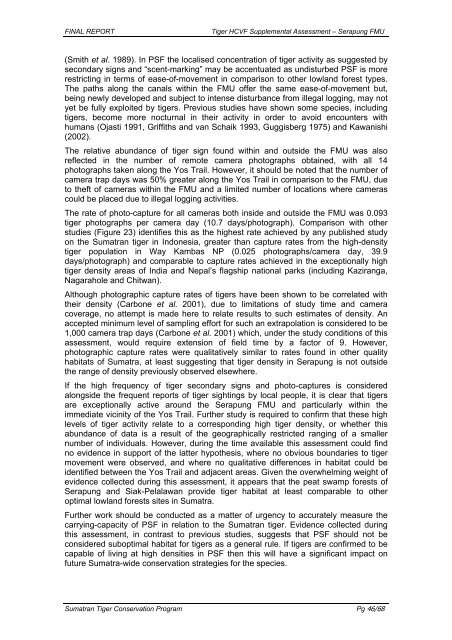A Supplemental HCVF Assessment on the Sumatran Tiger ...
A Supplemental HCVF Assessment on the Sumatran Tiger ...
A Supplemental HCVF Assessment on the Sumatran Tiger ...
You also want an ePaper? Increase the reach of your titles
YUMPU automatically turns print PDFs into web optimized ePapers that Google loves.
FINAL REPORT <strong>Tiger</strong> <str<strong>on</strong>g>HCVF</str<strong>on</strong>g> <str<strong>on</strong>g>Supplemental</str<strong>on</strong>g> <str<strong>on</strong>g>Assessment</str<strong>on</strong>g> – Serapung FMU<br />
(Smith et al. 1989). In PSF <strong>the</strong> localised c<strong>on</strong>centrati<strong>on</strong> of tiger activity as suggested by<br />
sec<strong>on</strong>dary signs and “scent-marking” may be accentuated as undisturbed PSF is more<br />
restricting in terms of ease-of-movement in comparis<strong>on</strong> to o<strong>the</strong>r lowland forest types.<br />
The paths al<strong>on</strong>g <strong>the</strong> canals within <strong>the</strong> FMU offer <strong>the</strong> same ease-of-movement but,<br />
being newly developed and subject to intense disturbance from illegal logging, may not<br />
yet be fully exploited by tigers. Previous studies have shown some species, including<br />
tigers, become more nocturnal in <strong>the</strong>ir activity in order to avoid encounters with<br />
humans (Ojasti 1991, Griffiths and van Schaik 1993, Guggisberg 1975) and Kawanishi<br />
(2002).<br />
The relative abundance of tiger sign found within and outside <strong>the</strong> FMU was also<br />
reflected in <strong>the</strong> number of remote camera photographs obtained, with all 14<br />
photographs taken al<strong>on</strong>g <strong>the</strong> Yos Trail. However, it should be noted that <strong>the</strong> number of<br />
camera trap days was 50% greater al<strong>on</strong>g <strong>the</strong> Yos Trail in comparis<strong>on</strong> to <strong>the</strong> FMU, due<br />
to <strong>the</strong>ft of cameras within <strong>the</strong> FMU and a limited number of locati<strong>on</strong>s where cameras<br />
could be placed due to illegal logging activities.<br />
The rate of photo-capture for all cameras both inside and outside <strong>the</strong> FMU was 0.093<br />
tiger photographs per camera day (10.7 days/photograph). Comparis<strong>on</strong> with o<strong>the</strong>r<br />
studies (Figure 23) identifies this as <strong>the</strong> highest rate achieved by any published study<br />
<strong>on</strong> <strong>the</strong> <strong>Sumatran</strong> tiger in Ind<strong>on</strong>esia, greater than capture rates from <strong>the</strong> high-density<br />
tiger populati<strong>on</strong> in Way Kambas NP (0.025 photographs/camera day, 39.9<br />
days/photograph) and comparable to capture rates achieved in <strong>the</strong> excepti<strong>on</strong>ally high<br />
tiger density areas of India and Nepal’s flagship nati<strong>on</strong>al parks (including Kaziranga,<br />
Nagarahole and Chitwan).<br />
Although photographic capture rates of tigers have been shown to be correlated with<br />
<strong>the</strong>ir density (Carb<strong>on</strong>e et al. 2001), due to limitati<strong>on</strong>s of study time and camera<br />
coverage, no attempt is made here to relate results to such estimates of density. An<br />
accepted minimum level of sampling effort for such an extrapolati<strong>on</strong> is c<strong>on</strong>sidered to be<br />
1,000 camera trap days (Carb<strong>on</strong>e et al. 2001) which, under <strong>the</strong> study c<strong>on</strong>diti<strong>on</strong>s of this<br />
assessment, would require extensi<strong>on</strong> of field time by a factor of 9. However,<br />
photographic capture rates were qualitatively similar to rates found in o<strong>the</strong>r quality<br />
habitats of Sumatra, at least suggesting that tiger density in Serapung is not outside<br />
<strong>the</strong> range of density previously observed elsewhere.<br />
If <strong>the</strong> high frequency of tiger sec<strong>on</strong>dary signs and photo-captures is c<strong>on</strong>sidered<br />
al<strong>on</strong>gside <strong>the</strong> frequent reports of tiger sightings by local people, it is clear that tigers<br />
are excepti<strong>on</strong>ally active around <strong>the</strong> Serapung FMU and particularly within <strong>the</strong><br />
immediate vicinity of <strong>the</strong> Yos Trail. Fur<strong>the</strong>r study is required to c<strong>on</strong>firm that <strong>the</strong>se high<br />
levels of tiger activity relate to a corresp<strong>on</strong>ding high tiger density, or whe<strong>the</strong>r this<br />
abundance of data is a result of <strong>the</strong> geographically restricted ranging of a smaller<br />
number of individuals. However, during <strong>the</strong> time available this assessment could find<br />
no evidence in support of <strong>the</strong> latter hypo<strong>the</strong>sis, where no obvious boundaries to tiger<br />
movement were observed, and where no qualitative differences in habitat could be<br />
identified between <strong>the</strong> Yos Trail and adjacent areas. Given <strong>the</strong> overwhelming weight of<br />
evidence collected during this assessment, it appears that <strong>the</strong> peat swamp forests of<br />
Serapung and Siak-Pelalawan provide tiger habitat at least comparable to o<strong>the</strong>r<br />
optimal lowland forests sites in Sumatra.<br />
Fur<strong>the</strong>r work should be c<strong>on</strong>ducted as a matter of urgency to accurately measure <strong>the</strong><br />
carrying-capacity of PSF in relati<strong>on</strong> to <strong>the</strong> <strong>Sumatran</strong> tiger. Evidence collected during<br />
this assessment, in c<strong>on</strong>trast to previous studies, suggests that PSF should not be<br />
c<strong>on</strong>sidered suboptimal habitat for tigers as a general rule. If tigers are c<strong>on</strong>firmed to be<br />
capable of living at high densities in PSF <strong>the</strong>n this will have a significant impact <strong>on</strong><br />
future Sumatra-wide c<strong>on</strong>servati<strong>on</strong> strategies for <strong>the</strong> species.<br />
<strong>Sumatran</strong> <strong>Tiger</strong> C<strong>on</strong>servati<strong>on</strong> Program Pg 46/68

















